关联容器
关联容器按关键字来保存和访问元素,顺序容器是按它们在容器中得位置来顺序保存和访问。关联容器支持高效的关键字查找和访问。关联容器和顺序容器一样都是模板,需指定类型。关联容器的迭代器都是双向迭代器,顺序容器中除了forward_list外都是。
标准库有8个关联容器,容器间的不同体现在三个维度上:每个容器**(1)或是一个set,或是一个map**;(2)要求不重复的关键字,或者允许重复关键字;(3)按顺序保存元素,或无序保存。
关键字multi表示允许关键字重复,关键字unordered表示无序保存。map和multimap定义在头文件map中;set和multiset定义在头文件set中;无序容器定义在头文件unordered_map和unordered_set中。
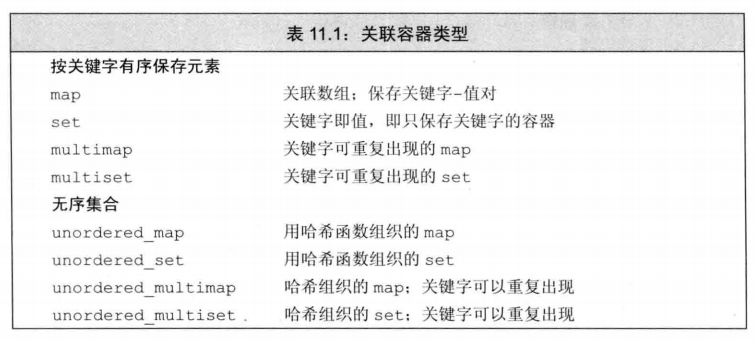
使用map
根据用户输入,统计各个单词输入次数:
int main()
{
map<string, size_t> word_count; // string 到 size_t的空map
string word;
while (std::cin >> word)
++word_count[word]; // 提取word的计数器并将其加1
for (const auto& w : word_count) // 遍历,得到的是一个pair类型对象。
{
cout << w.first << " occurs " << w.second
<< ((w.second > 1) ? " times" : " time") << endl;
}
}

从map提取元素时,会得到一个pair类型的对象。pair是一个模板类型,保存两个名为first和second的数据成员。
使用set
扩展前一个项目,将常用单词忽略:
int main()
{
map<string, size_t> word_count; // string 到 size_t的空map
set<string> exclude = { "The", "But", "And", "Or", "An", "A",
"the", "but", "and", "or", "an", "a" };
string word;
while (std::cin >> word)
{
// 统计不在exclude中的单词
if (exclude.find(word) == exclude.end()) {
++word_count[word];
}
}
for (const auto& w : word_count) // 遍历
{
cout << w.first << " occurs " << w.second
<< ((w.second > 1) ? " times" : " time") << endl;
}
}

扩展,忽略首字母大小写以及标点符号:处理字母大小写常见做法是在存储前统一将其转为全大写或全小写,我采用转为小写;标点符号则直接删除,ispunct 是 C++ 标准库 <cctype> 中的一个函数,它用于检查字符是否是标点符号。
if (exclude.find(word) == exclude.end())
{
// 转为小写
for (auto& ch : word) ch = tolower(ch);
// 删除标点
word.erase(remove_if(word.begin(), word.end(), ispunct), word.end());
++word_count[word];
}
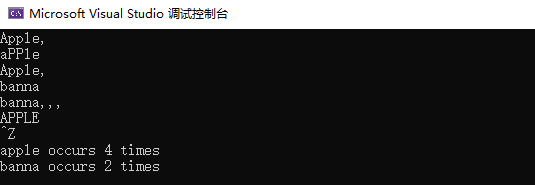
multimap与multiset
map与set中关键字必须唯一,一个关键字只能有一个元素的关键字等于它。加上multi后则不同,可支持多个元素具有相同的关键字。
vector<int> ivec;
for (vector<int>::size_type i = 0; i != 10; ++i) {
ivec.push_back(i);
ivec.push_back(i);
}
set<int> iset(ivec.cbegin(), ivec.cend());
multiset<int> miset(ivec.cbegin(), ivec.cend());
cout << ivec.size() << endl; // 20
cout << iset.size() << endl; // 10
cout << miset.size() << endl; // 20
关键字类型的要求
关联类型对其关键字类型有一些限制。对于有序容器,关键字类型必须定义元素比较的方法。默认情况下,标准库使用关键字类型的<运算符来比较两个关键字。集合类型中,关键字类型就是元素类型;映射类型中,关键字类型是元素的第一部分的类型。
若要提供自己定义的操作来代替关键字上的<运算符,所提供的操作必须在关键字类型上定义一个严格弱序(可看作“小于等于”)。
使用函数指针方式
class Book {
public:
Book(string bn = ""):isbn(bn){}
const string& getIsbn() const{
return isbn;
}
private:
string isbn;
};
bool compareIsbn(const Book& b1, const Book& b2) {
return b1.getIsbn() < b2.getIsbn();
}
int main()
{
vector<Book> bookVec = { Book("C3"), Book("C5"), Book("A3") };
// 隐式,使用decltype获取函数类型,然后加*
//multiset<Book, decltype(compareIsbn)*> books(compareIsbn);
// 显式,直接使用函数指针, 注意尖括号中为类型,不可使用函数指针变量
multiset<Book, bool (*)(const Book&, const Book&)> books(compareIsbn);
for (const auto& book : bookVec) {
books.insert(book);
}
cout << books.size() << endl; // 20
for (const auto& s : books) // 遍历
{
cout << s.getIsbn() << endl;
}
}
使用重载<方式
class Student {
public:
Student(string n = "", int a = 0):name(n), age(a){}
bool operator < (const Student& s) const {
return age < s.age;
}
public:
string name;
int age;
};
int main()
{
vector<Student> stuVec = { Student("C", 3), Student("A", 5), Student("A", 4) };
multiset<Student> students(stuVec.cbegin(), stuVec.cend());
cout << students.size() << endl;
for (const auto& s : students) // 遍历
{
cout << s.name << ": " << s.age << endl;
}
}
std::map 的键需要具备可比较的逻辑, std::list< 运算符。需提供比较函数,或比较器。
std::vector<int> vi;
mv.insert(std::pair<std::vector<int>::iterator, int>(vi.begin(), 0));
// but when using this one the compiler complained that
// error: no match for 'operator<' in '__x < __y'
std::list<int> li;
ml.insert(std::pair<std::list<int>::iterator, int>(li.begin(), 0));
pair
pair位于utility.h中,保存两个数据成员,类似容器,用于生成特定类型的模板。
// 初始化器
pair<string, string> author{ "James", "Joyce" };
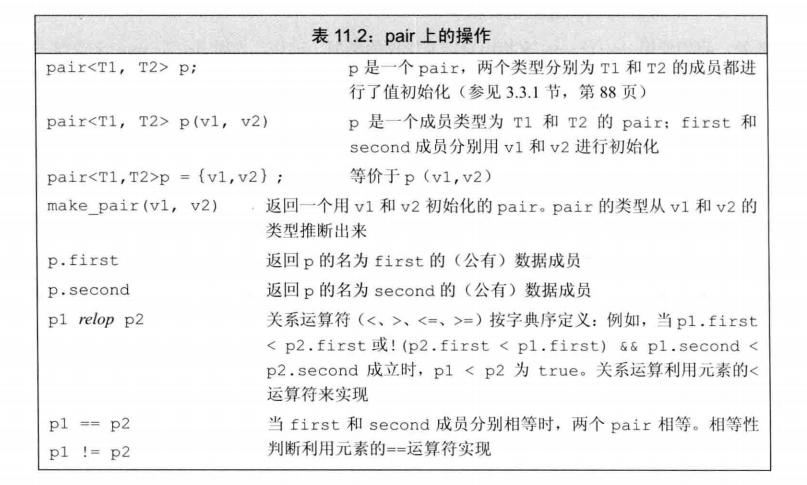
创建pair的方法:
int main()
{
std::vector<std::pair<std::string, int>> vec;
std::string str;
int i;
while (std::cin >> str >> i)
vec.push_back(std::pair<std::string, int>(str, i));
// vec.push_back(std::make_pair(str, i));
// vec.push_back({ str, i }); // 参数为一个pair
// vec.emplace_back(str, i); // 参数为一个构造, 最简洁
for (const auto& p : vec)
std::cout << p.first << ":" << p.second << std::endl;
}
关联容器操作

set类型的key_type和value_type相同;set中保存的值就是关键字。map中元素是关键字-值对,每个元素是一个pair对象,由于元素关键字不能改变,pair的关键字部分是const。
set<string>::value_type v1; // v1为string
set<string>::key_type v2; // v2为string
map<string, int>::value_type v3; // v3为pair<const string, int>
map<string, int>::key_type v4; // v4为string
map<string, int>::mapped_type v5; // v5为int,只有map类型才定义了此类型
关联容器迭代器
解引用一个关联容器迭代器时,会得到一个类型为容器的value_type的值引用。map的value_type是一个pair,可以改变pair的值,但不能改变关键字成员的值。set类型定义了iterator和const_iterator类型,但是都只允许只读访问set中的元素。
添加元素
关联容器使用insert时,在插入已存在的元素对容器没有影响。
vector<int> ivec = { 2, 4, 6, 8, 2, 4, 6, 8 }; // ivec有8个元素
set<int> set2; // 空集合
set2.insert(ivec.begin(), ivec.end()); // 4个元素
set2.insert({1, 3, 5, 7, 1, 3, 5, 7}); // 8个元素
map<string, int> words;
words.insert({ "aaa", 1}); // 使用{}初始化pair, word包含1个元素
words.insert(std::make_pair("aaa2", 3 )); // 显式构造pair, word包含2个元素
words.insert(pair<string, int>("aaa", 7)); // 显式构造pair, word包含2个元素, aaa - 1, aaa2 - 3
words.insert(map<string, size_t>::value_type("aaa", 5)); // 显式构造pair, word包含2个元素, aaa - 1, aaa2 - 3
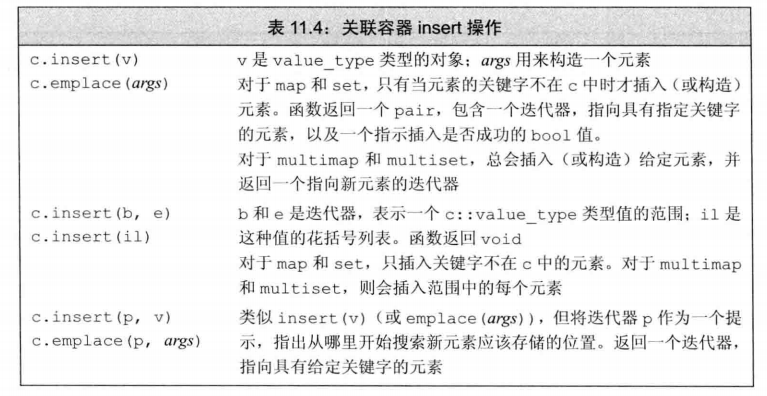
检测insert的返回值
insert(或emplace)返回的值依赖于容器类型和参数。返回一个pair,pair的first成员是一个迭代器,指向具有给定关键字的元素;second成员是一个bool值,指出元素是插入成功还是已经存在于容器中。
使用insert重写单词计数程序,区别是可以配置初始值:
map<string, size_t> word_count; // 从string到size_t的空map
string word;
while (std::cin >> word) {
// 插入一个元素,关键字等于word, 值为5;
// 若word已在word_count中,insert什么也不做
pair<map<string, size_t>::iterator, bool> ret = word_count.insert({ word, 5 });
if (!ret.second) // word已在word_count中
++ret.first->second;
}
可以将上述流程简化为:
while (std::cin >> word) {
++word_count.insert({ word, 4 }).first->second;
}
ret 为pair
ret.first 是一个map迭代器,指向具有给定关键字的元素
ret.first-> 解引用此迭代器,提取map中的元素,元素也是一个pair
ret.first->second map中元素的值部分
multiset或multimap 添加元素
在允许关键字不唯一时,insert总会插入一个元素,因此,insert无须返回bool值。
multimap<string, string> authors;
// 插入第一个元素
authors.insert({"Barth, John", "Son-Weed Factor"});
// 插入第二个元素,与前一个关键字相同
authors.insert({"Barth, John", "Lost in the Funhouse"});
删除元素

删除关键字时,不重复关键字的容器,erase返回值总是0或1,在允许重复关键字的容器,删除元素数量可能大于1。
map的下标操作
set不支持下标,因为set中没有与关键字相关联的“值”。multimap或unordered_multimap也不能进行下标操作,因为可能有多个值与一个关联字相关联。

当使用一个不在容器中的关键字作为下标,会添加一个具有此关键字的元素到map中。
map下标操作的返回值
通常情况下,解引用一个迭代器所返回的类型与下标运算符返回的类型是一样的。但map使用下标操作时,会获得一个mapped_type对象(每个关键字关联的类型);解引用一个map迭代器时,会得到一个value_type对象。
同其他下标运算符相同,map下标运算符返回一个左值,所以可进行读写。
访问元素
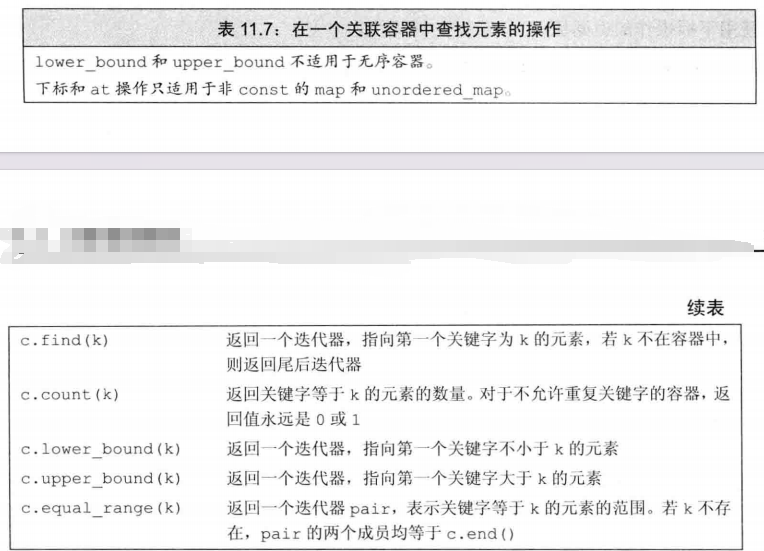
find方法不会添加将查找的关键字插入到map中。
在multimap或multiset中查找元素
multimap<string, int> authors;
authors.insert({ "a", 1 });
authors.emplace("b", 1);
authors.emplace("c", 1);
multimap<string, string> authors2{
{ "a", "1" },
{ "b", "1" },
{ "c", "1" },
{ "b", "1" }
};
1、先查找总个数,然后加个迭代器定位到第一个元素
multimap<string, string> authors;
string search_item("Alain de Botton"); // 要查找的作者
auto entries = authors.count(search_item); // 总数量
auto iter = authors.find(search_item); // 此作者的第一本书
// 循环查找所有
while (entries) {
cout << iter->second << endl; // 打印每个书名
++iter;
--entries;
}
2、使用lower_bound和upper_bound
for (auto beg = authors.lower_bound(search_item),
end = authors.upper_bound(search_item);
beg != end;
++beg)
cout << beg->second << endl; // 打印
当lower_bound(第一次出现)和upper_bound(最后一次出现之后)返回相同的迭代器时,则给定的关键字不在容器中。当元素不存在时,迭代器都会指向一个不影响排序的关键字插入位置。
3、使用equal_range函数
for (auto pos = authors.equal_range(search_item);
pos.first != pos.second;
++pos.first)
cout << pos.first->second << endl;
与第二种没有本质区别。
下标运算符对比
1、下标操作符在重复赋值相同关键字时,会保留最后一次的记录。insert会保留第一次的记录。
2、只能在非const类型的map上使用下标操作符,因为可能会插入一个元素。所有某些场景下只能使用find
文章评论